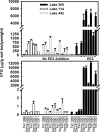Collapse of a fish population after exposure to a synthetic estrogen
- PMID: 17517636
- PMCID: PMC1874224
- DOI: 10.1073/pnas.0609568104
Collapse of a fish population after exposure to a synthetic estrogen
Abstract
Municipal wastewaters are a complex mixture containing estrogens and estrogen mimics that are known to affect the reproductive health of wild fishes. Male fishes downstream of some wastewater outfalls produce vitellogenin (VTG) (a protein normally synthesized by females during oocyte maturation) and early-stage eggs in their testes, and this feminization has been attributed to the presence of estrogenic substances such as natural estrogens [estrone or 17beta-estradiol (E2)], the synthetic estrogen used in birth-control pills [17 alpha-ethynylestradiol (EE2)], or weaker estrogen mimics such as nonylphenol in the water. Despite widespread evidence that male fishes are being feminized, it is not known whether these low-level, chronic exposures adversely impact the sustainability of wild populations. We conducted a 7-year, whole-lake experiment at the Experimental Lakes Area (ELA) in northwestern Ontario, Canada, and showed that chronic exposure of fathead minnow (Pimephales promelas) to low concentrations (5-6 ng x L(-1)) of the potent 17 alpha-ethynylestradiol led to feminization of males through the production of vitellogenin mRNA and protein, impacts on gonadal development as evidenced by intersex in males and altered oogenesis in females, and, ultimately, a near extinction of this species from the lake. Our observations demonstrate that the concentrations of estrogens and their mimics observed in freshwaters can impact the sustainability of wild fish populations.
Conflict of interest statement
The authors declare no conflict of interest.
Figures



References
-
- Harries JE, Sheahan DA, Jobling S, Matthiessen P, Neall P, Sumpter JP, Tylor T, Zaman N. Environ Toxicol Chem. 1997;16:534–542.
-
- Jobling S, Nolan M, Tyler CR, Brighty G, Sumpter JP. Environ Sci Technol. 1998;32:2498–2506.
-
- Lazorchak JM, Smith ME. National Screening Survey of EDCs in Municipal Wastewater Treatment Effluents. Cincinnati: United States Environmental Protection Agency; 2004. EPA Publ No 600/R-04/171.
-
- Desbrow C, Routledge EJ, Brighty GC, Sumpter JP, Waldosk M. Environ Sci Technol. 1998;32:1549–1558.
-
- Ternes TA, Stumpf M, Mueller J, Haberer K, Wilken R-D, Servos M. Sci Total Environ. 1999;225:81–90. - PubMed
Publication types
MeSH terms
Substances
LinkOut - more resources
Full Text Sources
Other Literature Sources

